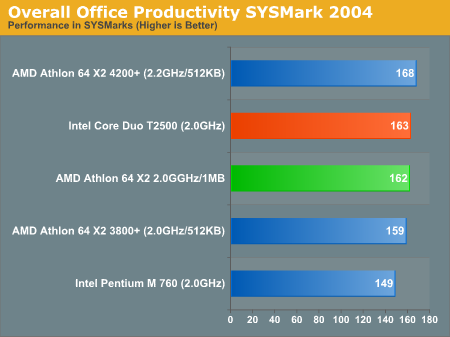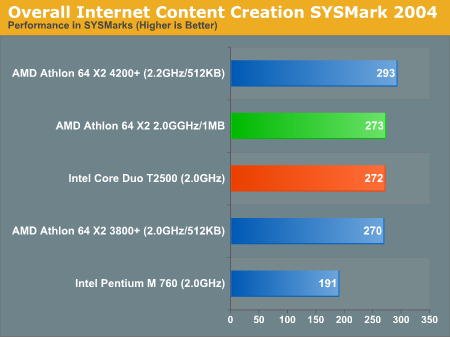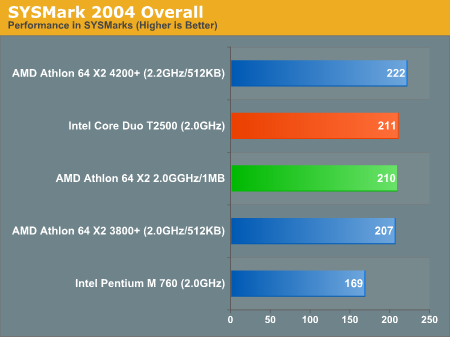Intel Core Duo (Yonah) Performance Preview - Part II
by Anand Lal Shimpi on December 19, 2005 12:55 PM EST- Posted in
- CPUs
Overall System Performance using SYSMark 2004
Office Productivity SYSMark 2004
SYSMark's Office Productivity suite consists of three tests, the first of which is the Communication test. The Communication test consists of the following:
Compared to the Athlon 64 X2, the Core Duo T2500 manages to slightly outperform the X2 3800+, but moving to a larger cache helps the X2 narrow that already small gap. Even though the Core Duo has a one-point lead, given the percentage, we'd call this one a tie.
The breakdown of the Office Productivity SYSMark 2004 score is listed below, higher numbers mean better performance:
ICC SYSMark 2004
The first category that we will deal with is 3D Content Creation. The tests that make up this benchmark are described below:
The breakdown of the ICC SYSMark 2004 score is listed below, higher numbers mean better performance:
Office Productivity SYSMark 2004
SYSMark's Office Productivity suite consists of three tests, the first of which is the Communication test. The Communication test consists of the following:
"The user receives an email in Outlook 2002 that contains a collection of documents in a zip file. The user reviews his email and updates his calendar while VirusScan 7.0 scans the system. The corporate web site is viewed in Internet Explorer 6.0. Finally, Internet Explorer is used to look at samples of the web pages and documents created during the scenario."The next test is Document Creation performance:
"The user edits the document using Word 2002. He transcribes an audio file into a document using Dragon NaturallySpeaking 6. Once the document has all the necessary pieces in place, the user changes it into a portable format for easy and secure distribution using Acrobat 5.0.5. The user creates a marketing presentation in PowerPoint 2002 and adds elements to a slide show template."The final test in our Office Productivity suite is Data Analysis, which BAPCo describes as:
"The user opens a database using Access 2002 and runs some queries. A collection of documents are archived using WinZip 8.1. The queries' results are imported into a spreadsheet using Excel 2002 and are used to generate graphical charts."

Compared to the Athlon 64 X2, the Core Duo T2500 manages to slightly outperform the X2 3800+, but moving to a larger cache helps the X2 narrow that already small gap. Even though the Core Duo has a one-point lead, given the percentage, we'd call this one a tie.
The breakdown of the Office Productivity SYSMark 2004 score is listed below, higher numbers mean better performance:
| OP SYSMark 2004 Score Breakdown | AMD Athlon 64 X2 4200+ | AMD Athlon 64 X2 3800+ | AMD Athlon 64 X2 2.0GHz/1MB | Intel Core Duo T2500 | Intel Pentium M 760 |
| Communication | 148 | 144 | 146 | 146 | 140 |
| Document Creation | 219 | 204 | 211 | 215 | 203 |
| Data Analysis | 145 | 136 | 138 | 138 | 117 |
ICC SYSMark 2004
The first category that we will deal with is 3D Content Creation. The tests that make up this benchmark are described below:
"The user renders a 3D model to a bitmap using 3ds max 5.1, while preparing web pages in Dreamweaver MX. Then the user renders a 3D animation in a vector graphics format."Next, we have 2D Content Creation performance:
"The user uses Premiere 6.5 to create a movie from several raw input movie cuts and sound cuts and starts exporting it. While waiting on this operation, the user imports the rendered image into Photoshop 7.01, modifies it and saves the results. Once the movie is assembled, the user edits it and creates special effects using After Effects 5.5."The Internet Content Creation suite is rounded up with a Web Publishing performance test:
"The user extracts content from an archive using WinZip 8.1. Meanwhile, he uses Flash MX to open the exported 3D vector graphics file. He modifies it by including other pictures and optimizes it for faster animation. The final movie with the special effects is then compressed using Windows Media Encoder 9 series in a format that can be broadcast over broadband Internet. The web site is given the final touches in Dreamweaver MX and the system is scanned by VirusScan 7.0."

The breakdown of the ICC SYSMark 2004 score is listed below, higher numbers mean better performance:
| ICC SYSMark 2004 Score Breakdown | AMD Athlon 64 X2 4200+ | AMD Athlon 64 X2 3800+ | AMD Athlon 64 X2 2.0GHz/1MB | Intel Core Duo T2500 | Intel Pentium M 760 |
| 3D Content Creation | 271 | 248 | 251 | 264 | 181 |
| 2D Content Creation | 340 | 312 | 314 | 323 | 238 |
| Web Publication | 274 | 254 | 257 | 236 | 162 |











103 Comments
View All Comments
Shintai - Monday, December 19, 2005 - link
I doubt a a laptop uses 108W and got a x800XT. That powerchart is close to useless.A Core Duo laptop is 31 peak for CPU and 2.5 for the 945GM. A single core tution is 35W. unless you want 25W part, but then we gotta use the lower intel part aswell.
Dualcore Turion wont even stand a chance until it get 65nm.
Furen - Tuesday, December 20, 2005 - link
The 25W Turion parts are $5 more expensive than the 35W parts, hardly comparable with the price difference between regular and LV Intel CPUs. I agree with you in that I dont expect 90nm Turions to match Yonah's power consumption but I must say that what I've heard about the Yamato platform (which, to tell the truth, is almost nothing) makes me think that it'll be a closer match than we think.Missing Ghost - Monday, December 19, 2005 - link
What, no 64 bit?I won't buy this.
fitten - Tuesday, December 20, 2005 - link
Do you actually use 64-bit or is it just a feature checkbox? I bought some Athlon64s because they were 64-bit and allowed me to test the software I write on a 64-bit platform, for example... not that the codes I actually write require many of the features of 64-bit, though. In the past, I have written and worked on a number of projects that actually need 64-bit (typically just very large datasets which can just be used flat in 64-bit as opposed to all sorts of tiling and paging on a 32-bit machine).Chickan - Monday, December 19, 2005 - link
Did anyone else notice that the numbers in the graph for Black and White did not match up with the spreadsheet below it? According to the graph, the Core Duo hit 44.5 FPS, the same as the X2 2ghz w/ 1mbx2, but in the sheet below, it is reported to only do 40.1 FPS, lower than even the Pentium M. In fact, it performs the worst out of all the CPU's there, at every resolution, even though this is not reported, nor mentioned.I also find it interesting that Intel's new line is only able to match X2's, not beat them. Either way, lets see some new stuff from AMD!
KazenoKoe - Monday, December 19, 2005 - link
Odd, the article clearly has it at 42.3fps on both the graph and the table. The Pentium M got 40.1 and the X2 2GHz/1MB got 44.5.WitchKing - Monday, December 19, 2005 - link
I enjoyed reading this 2nd article on the next Intel platform.Although I am basically in favor of AMD since Athlon platform, I am quite glad that Intel is closing the performance gap. It will make AMD move further ;-)
Anyway, it should be quite interesting to see how these 2 platforms compare in 64-bits tasks (Windows XP-64, Vista (is a 64-bits version available yet?) and linux based).
A 3rd opus of this article maybe? ;-)
saratoga - Monday, December 19, 2005 - link
Yonah does not support x86-64, so doing 64 bit testing is not possible.phaxmohdem - Monday, December 19, 2005 - link
I thought this review was much better than the first. Thanks guys. It pretty much illustrates the same thing, but it is interesting to read about new CPU's none the less.I don't mind the name personally, I think that we uber-nerds don't like it because we actually know what a core is in regards to a CPU. Your typical idiot customer doesn't know what a Core, or Processor die is, and Core is just another brand name like Pentium.
While these chips look freaking awesome for laptop use, I must admit I will ver very dissapointed it Conroe launches, and only brings Intel back to equality with AMD. When a new generation of CPU launches, I generally like to think that they are releaseing something to regain their status as performance leader, not just level the playing field. (Though I guess PII/PIII/P4 al launched with worse performance than the high end of their predecessors)
tfranzese - Monday, December 19, 2005 - link
If memory serves, the only one to launch with a loss in performance was the Pentium 4. The Pentium II was a great advancement over the Pentium it replaced (not the Pro) and the Pentium III performed equally, though was available at higher clock speeds. That said, I don't know where you got to grouping the PII and PIII in with the P4's poor launch status. Willamette was a joke.